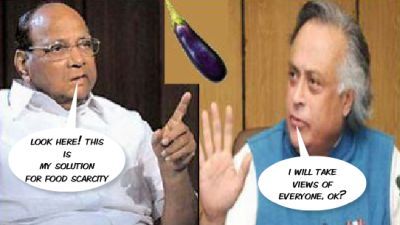Have a Bt Brinjal a Day - Part I
Part I
An unprecedented and furious debate has been raging due to the imminent introduction in India of the first GM food, Bt Brinjal which was recently recommended for release by the official Genetic Engineering Approval Committee, GEAC (aptly mentioned in a government memorandum as Genetic Approval Engineering Committee – a Committee to engineer approvals).
see here.
But the GM foods (termed Frankenfoods by many) controversy was not born then. Brinjal transformation in India was initiated as early as 2000. Prior to that the initiation of Bt Cotton started with approval for import of transgenic seeds in 1995 and the release of Bt Cotton was finally approved in 2002. Grave concerns have been and are continuing to be raised all over the world about GM agricultural products all through their journey for nearly two decades.
The concerns being raised have so far not being satisfactorily addressed and the Government appears determined to allow the first GM food into the food chain.
The main issues, about which people are and ought to be concerned, are: Ethical, Health and Environment and larger issues of Public Policy.
Leaving the much larger ethical issue aside, although it deserves to be debated, it is critical to examine the other two issues in detail as this first approval or rejection may be a momentous decision for the country and for the people in the present time and the future generations. For this reason, the people should be involved and engaged in this discussion, not merely shrug it off by accepting whatever the advocates of the GM foods or the Government dish out. For a broad idea of the specific issue of Bt Brinjal, it is useful to refer to this publication by the Ministry of Environment & Forests.

Immediately after the GEAC recommendation was made on 14.10.2009, the groundswell of protests gained momentum following which the Environment Minister Jairam Ramesh announced holding consultations with all interests before taking a decision. With his public hearings still underway, Pawar reportedly objected saying that the GEAC approval was final and the central government did not have any say in the issue. see here . By experience, people know by now that utterances of Pawar are best ignored when it comes to judging public interest as opposed to private interest. Jairam rightly opposed his stand. Even the GEAC had said “Since this decision of the GEAC will have major policy implications, the GEAC decided to forward the recommendations and report of the Expert Committee….to the Government for a final view”. (Here)

The mind of the Government is already made up
The public consultations may well be a mere charade to give the appearance of taking a balanced view for a decision that is already made elsewhere and balance already tilted on one side. The Government is known to work in this manner. The Prime Minister has hinted at an imminent positive decision stressing only on “appropriate regulatory control based on strictly scientific criteria”. (see here) Clearly he and his ministers know what the decision must be.
If the Government really wanted to have an informed debate involving the people on this crucial issue, it should have published long back a Green Paper. Rather than wasting 100s of crores of rupees from public funds on advertisements for promotion of politicians and announcing inauguration of minor events, it should have undertaken a major advertisement campaign fairly and transparently placing before the people the issues and the views of both the sides of the debate without giving out its own comments as it has done at this late stage by means of the Primer which is still not available widely. Obviously the people are just guinea pigs. How can it be believed that it genuinely wants to consider the views of the people?
Commercial Interests
Those who object to GM foods are also concerned about the fact that the entire movement for GM foods appears to be strongly driven by global commercial entities whose record is far from clean and who are the real beneficiaries at the cost of the supposed beneficiaries. See the reports here and here .
If the likes of Walmart having a plain retail business can lobby to enter into India, Monsanto can hardly be blamed for trying to sell their technology based product. Such interested parties have been extolling the virtues of their offerings from Retail trade to Branded Consumer products to GM foods and the Government has been lapping up their exaggerated claims and placing cut-and-paste copies before the people. The same arguments –“farmers will benefit”, “consumers will benefit” - applied for FDI in Retail are also being applied to GM foods. See here and here.
Like all good salesmen whether they sell wonder wash detergent or magical weight loss program or double-your-money scheme, they will exaggerate to a point where customers will feel left out if they do not buy. Ultimately, it is left to the sanity and good sense of governments and the people to separate the chaff from the wheat. It would not be far fetched to say that especially in the case of GM foods, it is akin to a pusher tempting a potential customer for drugs which would lead to dependency. Caveat emptor – let the buyer beware.
Wonderful things GM foods will do
These salesmen claim that GM foods will dramatically reduce insecticide use, increase yield, faster growth, impart beneficial properties etc. The claims are limited only by the seller’s inventive genius. E.g.
- Food that can deliver vaccines- banana that can produce Hepatitis B vaccine (why??)
- Perhaps, Apple with the texture of jelly, taste of Jackfruit and shape of a beer can?
What Bt Brinjal involves
Brinjal is a plant native to India and is produced in India for over 4000 years. The country produces over 9.6 million tons of Brinjal annually with the top four producing States being West Bengal (29%), Orissa (20%), Bihar (12%) and Gujarat (10%) accounting for over 70% of the total. Apart from other pests, the main pest that attacks Brinjal is the Fruit and Shoot Borer (FSB). The Bt Brinjal variety is specifically developed to control the FSB which develops inside the fruit making it difficult to control it except with precisely timed pesticide application before it reaches the inside.
Bt Brinjal is a transgenic product made by inserting the toxin Cry1AC from bacterium B. Thuringiensis into Brinjal to induce resistance specifically to FSB. It is like the toxin getting under the skin of Brinjal and acting as toxin for the FSB resulting in its death. It would appear that the dead FSB would still remain within the fruit. Further, to an average person, it would seem that once the toxin is inside the fruit (even as a protein), it would logically remain there and get into the human body when it is consumed. It is also known that the pests develop resistance to pesticides over time, but it is claimed that in case of Bt toxin within the fruit, no such resistance would be developed. The scientists have tried to explain the issue and it is best left to the experts to agree or disagree on the same. But it does alter the genetic pattern of the food which has been developed over millennia.

Health and Environment issues
Many issues have been raised by experts and NGOs on health and environment related issues not only of Bt Brinjal but also GM foods per se. The objections are not peripheral but substantial and far from being emotional. It is not mere scaremongering. If the GM food advocates want scientists’ views to be respected, so also should the opposing views from scientists be respected. The fact that there is an overwhelming body of objectors, distinguished scientists and academicians themselves and with no apparent vested interest to oppose GM foods lends significant credence to the arguments of those who protest against GM foods. Just one article will indicate the status of the objectors and what they have to say. See Statements by Scientists. Also see: Highway to genetic holocaust and a Letter from Prof. Schubert of the highly respected Salk Institute. (More references are given at the end of this article and may be referred to.)
The Expert Committee Report does seem to have considered in detail the findings on the large scale tests and also tried to respond to many of the questions raised about the findings, including the points of Prof. Seralini (see here) and Dr. P. Bhargava, (an invitee as directed by the Supreme Court), on whom some are placing reliance to voice their own objections.
But there are aspects related to the EC II Report and the GEAC meeting at which the same was approved, which raise concern about the way in which the matter has been gone about (engineered?)
1. Decision of GEAC was hurriedly taken within just 6 days of submission of the EC II Report.
3. It is accepted that Brinjal has its origin in India. see a Ministry Document and also see a Patent application on Bt Brinjal as also the position of National Bureau of Plant Genetic Resources. The Cartagena Protocol on Biosafety has provisions that discourage genetic modification of crops in their land of origin. Apparently in order to get around this provision, the EC-II cited references just to show that there was no certainty about the origin of Brinjal.
4. CFTRI representative on the GEAC had suggested to test the Bt Brinjal for flavour which is an essential element of any food item apart from taste, texture, cooking quality and composition, Inexplicably, CFTRI refused to do the test on transgenic food. The EC-II decided to ignore this saying that the test was not required. This may be strictly true but doubts remain about the issue.
5. EC-II has noted that “Adoption of transgenic crops engineered primarily using the cry proteins to prevent damage caused by insect pests has given excellent results in cotton and maize worldwide resulting in significant economic benefits. A similar approach in brinjal is expected to provide substantial benefits to farmers.” The term “worldwide” has been freely used in the Report to suggest that if the entire world is accepting it (false), India must do it too. The term “worldwide” is designed to mislead. By far the main production is confined to the American Continent with USA being the biggest. In the USA itself, GM crop production actually increased pesticide use by more than 4 percent between 1996 and 2004 (see here) It is more true that there is a worldwide disagreement on the need and desirability of GM products.
6. The GEAC opined that the cry1Ac gene incorporated in Bt brinjal event EE-1 is 100% identical to the one expressed in Bt cotton event MON-531 approved in India and globally. The fact is that the same is approved in the case of cotton and more important, the term “globally” is used to show as if Bt Cotton is grown all over the world which is not so.
7. How bt brinjal was cleared ( see here)
8. EC-II has rightly focused only on the prescribed tests saying that Regulatory mechanism is a dynamic process which is continuously updated based on scientific developments and evidences. But in the first place,there are doubts about the initial parameters set for the tests. The fact that decisions are based on these tests also shows that if subsequent evidence raises serious issues, it would be too late to correct the situation. This becomes important precisely because the discussion relates to products entering the food chain. Science is replete with examples, starting with DDT and now encompassing even the later-day pesticides, of how inventions hailed as panacea are now recognized as harmful by the very scientists who might have once promoted them enthusiastically and unreservedly.
9. The scientists making the recommendations have already given enough caveats to make it clear that they are basing their decisions on the tests as prescribed, on the findings as presented and on the basis of existing knowledge. See this: “Our collective wisdom is limited on recombinant technology. Therefore, we are treading carefully. Decisions have been based on current evidence in science. But, we must have a system of post-marketing surveillance to assess health impacts,” and “Brinjal is not a staple food for anybody. Unless the (GM) product is in use, how can we say? What will happen in the future is anybody’s guess” a member of GEAC expert committee, Vasantha Muthuswamy, said. In any case, she said, “the Bt gene may already have become a part of the food chain, as Bt cotton cakes are being used in animal feed and fodder.” (see here) Such remarks ring loud alarm bells and confirm that the scientists simply do not know enough at this stage and they would like the products to be first released in the food chain. It also shows that the Government approved Bt Cotton earlier without even considering that the product could enter the food chain. It would be reckless to repeat the same for an item of direct use without regard for the real fears and apprehensions already expressed by other equally or more knowledgeable scientists.

Bizzare Arguments
To push the case for GM foods, some really bizarre arguments have been used. For example:
a. EC-II, while rejecting the need for additional tests proposed by Dr. Bhargava, invitee at the instance of the Supreme Court, said “Raising the bar of the regulatory process based on hypothetical concerns and apprehensions would be highly detrimental for research and development in the area of agricultural biotechnology especially for public sector institutions.” It is an outrageous suggestion that just because research is done by a public sector institution it should be spared rigorous requirement even where human health and environment concerns so demand.
b. Another advocate from abroad one Prof. Kershen has written to the Environment Minister giving some bizzare arguments including “By failing to approve the commercial cultivation of Bt brinjal, India runs the very strong risk of discouraging agricultural research and development. India needs and deserves agricultural research and development from its scientists to reduce poverty and to remain competitive. But they cannot provide that research and development if their efforts are thwarted. ” (see here) Does this mean that the products need to be approved just to make the scientists happy?? No true researcher or scientist gets discouraged if his efforts do not yield fruit because that is inbuilt in the nature of his work, nor does any business get discouraged if one of its ventures fails. And why is HE pleading for scientists of a private entity? To present such an argument is to insult the intelligence of the Minister. The Professor says that he has been following the matter closely since 2000. The contents of his letter are enough to suggest that vested interests may be involved. Even assuming that it is not so, the arguments are worth ignoring.
(contd.)
It is time for the People to speak up


5 Comments:
nice
I felt that this was enormous material for a vegetable & that too brinjal ! I have also penned a blog post on the subject but in a lighter vein !Pl check it out @ http://vasu-smaran.blogspot.com/search?q=bt+brinjal
I am averse to brinjal-whatever form it is in.But I would say that let us be cautious & not jump in for MNC branded stuff.
dear sir
your articles are excellent,i simply say nobody should engineer nature for their idiotic and selfish gains..all the bloody animals in Monsanto should be feeded with money for one week ,if they survive we can acccept bt-brinjal-rajesh
with my project on the controversy of Bt Brinjal and its effect as part of business environment.
but one thing that i would like to tell is that scientific name Bacillus thuringenesis has to be written using a specific format i.e. the entire name should be in italics with the first word starting in capitals and the second in small caps.
it might be a small information but thought of adding...
thanks to rhea for the info. the correct nomenclature is
Bacillus Thuringiensis can also be written as B. thuringiensis
the words are written in capitals only in the image just to make them better visible.
Post a Comment
<< HOME